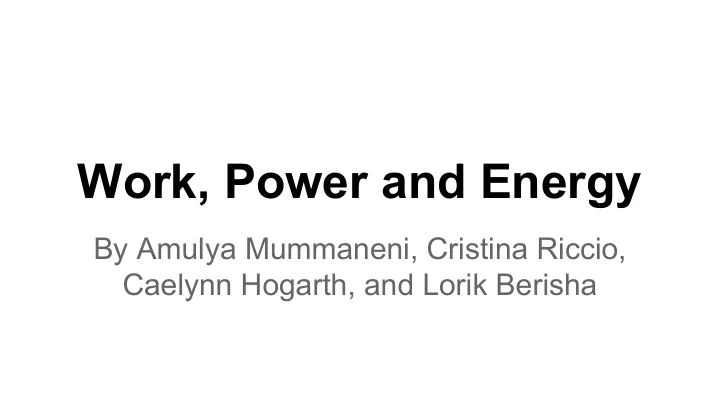

Work, Power and Energy By Amulya Mummaneni, Cristina Riccio, Caelynn Hogarth, and Lorik Berisha
Work W = ΔKE = KE final - KE initial
Power
Energy Equations Rotational kinetic Kinetic energy Gravitational potential energy energy Spring potential energy
Conservation of Energy ● The total energy in a system is the same at any point. ● Energy before = Energy after ● PE + KE = Energy total ● So...
Conceptual problems
#1- Work If the net work done on an object is positive, then the object's kinetic energy: a. increases b. remains the same c. decreases d. is zero
#2- Energy A lightweight object and a very heavy object are sliding with equal speeds along a level frictionlesssurface. They both slide up the same frictionless hill. Which rises to a greater height? a. The heavy object, because it has greater kinetic energy. b. The lightweight object, because it weighs less. c. They both slide to the same height. d. Cannot be determined from the given info.
#3- Work Can work be done on a system if there is no motion? a. No, since a system that is not moving has no energy. b. Yes, if an outside force is provided. c. Yes, since motion is only relative. d. No, because of the way work is defined.
#4- Work An object is released from rest a height "h" above the ground. A second object with four times the mass of the first is released from the same height. The potential energy of the second object compared to the first is: a. 1/4 as much b. 4 times as much c. 1/2 as much d. Twice as much
#5- Work If you push twice as hard against a stationary brick wall, the amount of work you do: a. remains contant at zero b. is cut in half c. doubles d. remains constant but non-zero
#6- Work A 500-kg elevator is pulled upward with a constant force of 5500 N for a distance of 50.0 m. What is the work done by the 5500 N force? a. 2.75 x 10^5 J b. -5.2 x 10^5 J c. -2.45 x 10^5 J d. 3 x 10^4 J
#7- Work A 500-kg elevator is pulled upward with a constant force of 5500 N for a distance of 50.0 m. What is the work done by the weight of the elevator? a. 2.75 x 10^5 J b. 3 x 10^4 J c. -2.45 x 10^5 d. -5.2 x 10^5
Math-y problems
#1 - Work Problem How far can a mother push a 20.0 kg baby carriage, using a force of 62.0 N at an angle of 30.0° to the horizontal, if she can do 2920 J of work?
#2 - Work Problem A girl pushes her little brother on his sled with a force of 300 N for 750 m. How much work is this if the force of friction acting on the sled is (a) 200 N, (b) 300 N?
#3 - Power Problem How many joules of energy does a 100-watt light bulb use per hour? How fast would a 70 kg person have to run to have that amount of kinetic energy?
#4 - Energy Problem At the moment when a shotputter releases a 7 kg shot, the shot is 2 m above the ground and travelling 16 m/s. It reaches a maximum height of 15.5 m above the ground and then falls to the ground. If air resistance is negligible, a. What was the potential energy of the shot as it left the hand relative to the ground? b. What was the kinetic energy of the shot as it left the hand c. What was the total energy of the shot as it reached its maximum height? d. What was the potential energy of the shot at its maximum height? e. What was the kinetic energy of the shot just as it struck the ground?
#5 - Energy Problem An unknown force is applied to a 12 kg mass. The force acts at an angle of 30° above the horizontal. Determine the force acting if the force acts for a horizontal displacement of 22 meters and increases the mass’s speed from 11 m/s to 26 m/s.
Recommend
More recommend